SAN MIGUEL CORPORATION’S OFFICE BUILDING
Landmark for a better world
Forty years ago an iconic structure was completed on the sprawling expanse of the Ortigas business district. The distinctive shape of the San Miguel Corporation Head Office building dominated the area’s skyline and was clearly visible from EDSA.
The distinctiveness of the building lay in its pyramidical geometry, more specifically a flat ziggurat. The Mañosa brothers’ firm (Manuel, Jose and Francisco “Bobby” Mañosa) were the architects chosen by the blue-chip corporation for the job of creating a head office complex.
They were inspired by the Banawe rice terraces and strove to create one of the first green buildings in the country.

The project came to mind recently because of a cache of images of the complex sent to me by Sharon Floro, who took the images in 1984 (other photos are by her partner Bob Harris and brother Mark Floro). Sharon had worked for the National Artist IP Santos, who was the landscape architect of the project. Santos was retained by the San Miguel Corporation to provide a fitting setting for the six-hectare complex, the largest in this section of the district.
I had worked on the project as a junior designer at IP Santos’ firm. At its inception, I remember attending a number of coordination meetings presided over by the Mañosas. They explained that the building was meant to conserve energy with proper orientation (north-south axis). Natural lighting was also a goal, with no part of the interior more than 15 meters from the perimeter band of window, which was slanted to minimize glare and heat gain.
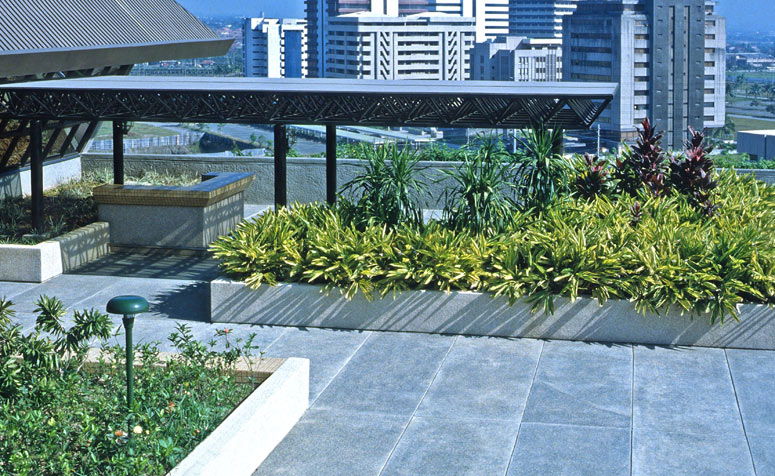
The windows were slanted with similarly angled sun breakers, an inspiration from the nipa hut.
IP Santos provided the continuous planters around each floor, contributing to the whole aesthetic, as well as the functional intent of the design. The sunshades were meant eventually to hold solar panels, and the perimeter planting was to have a sensor-aided irrigation system. Unfortunately, these technologies were still not viable at the time (1979).
IP Santos designed the grounds with ponds, pocket gardens and a jogging track to supplement the facilities in the staff gym. A roofed “social area,” edged with more landscape, provided a protected transition into the building and was meant to connect future wings to the main structure.
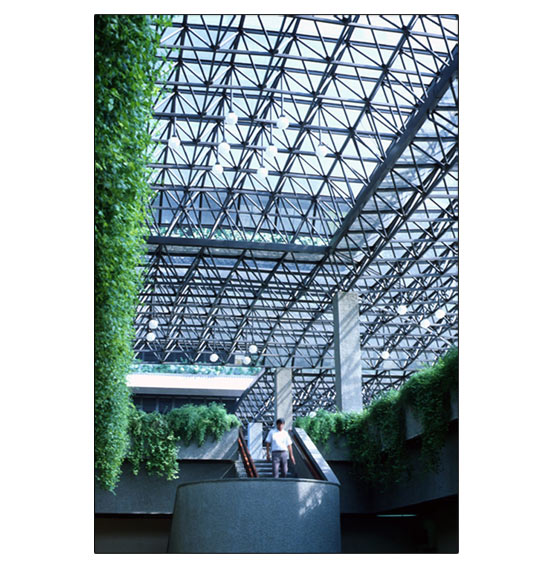
Santos also designed a new type of “tropical” parking layout that ensured complete shade for vehicles and provided visual screening to mitigate the sight of parked cars. He also innovated with an “invisible” fence all around the site, incorporating thick verges of bougainvillea and agaves that prevented any intrusion, while providing a more pleasant buffer with the outside.
Another signature Santos contribution was the gate and entry portal design, which reflected and complemented the ziggurat shape of the main building.
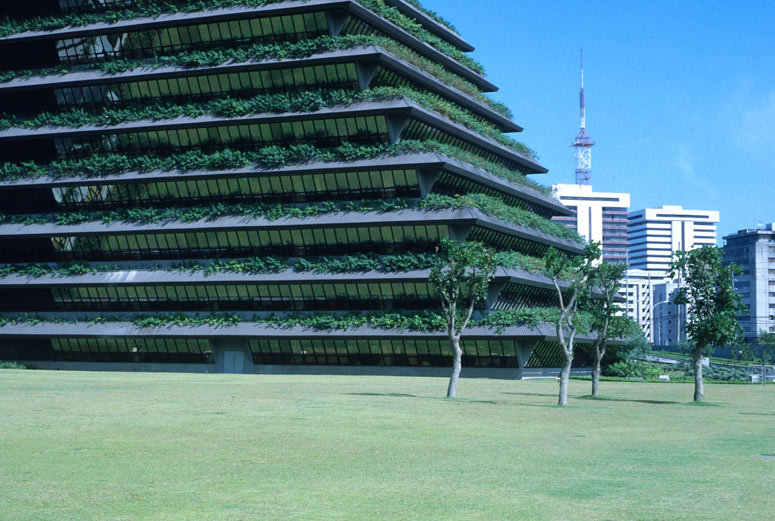
After four decades, the complex has been very well maintained, with little to compromise it. An office building was built on the corner nearest the Shangri-La, with similar window treatment as the main building. The landscape of IP Santos has also been well maintained and, together with the greenery-filled building, makes the whole complex the greenest in the district.
In a post-pandemic world, the importance of providing a balance of green open spaces to built-up areas has proven to be a plus for any section of the metropolis.
The Ortigas Central Business District itself filled up in the intervening decades. The ADB complex, another sprawling office campus, was built in the 1990s. Megamall was followed closely by Robinsons and the Shangri-La complexes to close off the EDSA edge of the district.
After the huge twin-tower development of Tektite Towers nearby, the rest of the district started shooting up vertically to maximize usage of much smaller building lots. Little greenery has been provided since (except for the small Ortigas Park, which I had designed for the Ortigas Corporation in the mid-2000s).
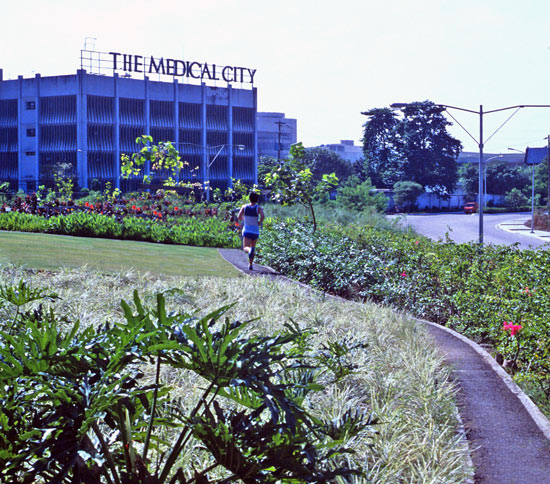
Today, the Ortigas CBD competes with the likes of Makati and BGC as a preferred business address for corporations and enterprises.
Like these other business enclaves, Ortigas CBD, though its building owner’s association, has endeavored to enhance the urban design of its districts with better pedestrian connectivity and traffic management. Streetscape improvements and continuous maintenance have also been key to sustaining the district’s environmental quality as well as property values.
In a post-pandemic world, the importance of providing a balance of green open spaces to built-up areas has proven to be a plus for any section of the metropolis.
Ortigas Center is now very much a mixed-use district with thousands living in high-rise condominiums. San Miguel’s greenery provides an oasis that benefits both its employees, as well as the surrounding community. The company itself has taken up sustainability as essential to its corporate goals and vision.
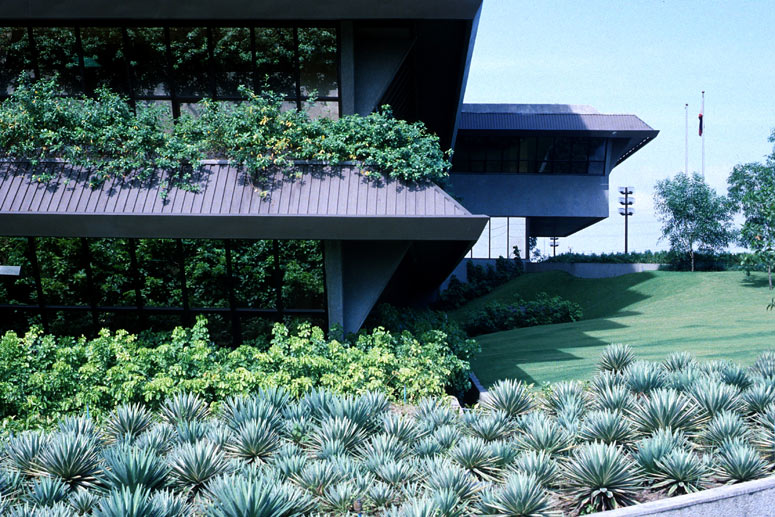
The complex is a legacy of Philippine architectural and landscape design, with an enlightened client and two National Artists — Bobby Mañosa and IP Santos — contributing to its creation.
Like its owners, the San Miguel complex has contributed immensely to the betterment of Philippine society and material culture, serving as an exemplar of Filipino creativity and innovation. A better world and a better future lie in store for us all if we keep on building as San Miguel has for all its decades in the country.
Banner and thumbnail caption: The San Miguel building by the Mañosa brothers is an exemplar of green architecture that was ahead of its time.


